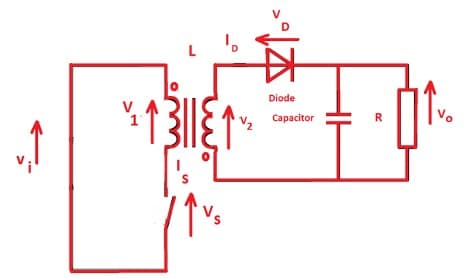As we all know, a transformer is an electrical device that converts voltage levels, either stepping up or stepping down, through mutual induction.
A flyback transformer is a unique type of step-up transformer designed to produce high-voltage signals with significant voltage-boosting capability. It’s commonly used in applications like picture tubes and CRT televisions.
With an input of 230 V, a flyback transformer can output around 20,000 V. It can even function effectively with lower input voltages, such as 12 V or 5 V
Design of Flyback Transformer
It consists of a small number of electrical components. A switching device consisting of transistors or MOSFETs is present at the input to cut-on and cut-off the input voltage of the primary coil. The secondary coil has a diode that restricts the current flow in reverse bias.

Unlike normal transformers, a flyback transformer is designed in such a way that it can be excited using DC voltage. The primary winding is driven by a switch using DC supply. When the primary coil gets energized, the magnetic flux is transferred to the secondary coil. But since the secondary coil is connected to a diode in reverse bias, the current gets stored. Therefore the next incoming pulse from the primary winding adds on this stored current (i.e the energy stored in the previous pulse). This subsequent addition results in a very high pulse of electricity at the output.
Principle of Flyback Transformer
A flyback transformer works by storing energy in the form of a magnetic field during the first half-cycle and then releasing that energy with reverse terminal voltage. The device uses a diode (also known as a flyback diode) to conduct and stop the energy transmission.

When the primary coil switch is in the on-state then due to inductance, electrical current is built up. The secondary coil connected to the flyback diode in series opposes the current formation. Instead, the energy gets stored in the magnetic core.
Current when switched off
When the primary coil switch is in the off-state, the voltage polarity is reversed due to the magnetic law of induction, causing the diode to shift to forward bias. So now, the secondary coil starts conducting current.
Advantage of Flyback Converter
- Multiple voltages can be supplied while isolated from the primary winding.
- Multiple voltages can be regulated with a single control
- Can operate across a wide range of input voltage
Flyback vs. Forward Transformer Comparison
Flyback vs. Forward: A simple comparison with forward transformers can show the unique use situations where flyback is desirable, particularly in applications requiring isolated, high-voltage output with low power consumption.
Application of Flyback Transformer
- CRT television to control horizontal control beam
- Telecommunication system for DC-DC voltage conversion
- Aeronautics for getting high voltage electric supply
- Electric converters use this transformer in fluctuating frequencies and convert low voltage to high voltage
- These transformers are also used along with industrial motors, generators and pumps
Safety and Standards
- Isolation: Windings are adequately separated according to IEC 61558 and UL 60950-1.
- Thermal Protection: Use UL 1446-rated insulation and heatsinks to prevent overheating.
- Transient/Surge Protection: Snubber circuits and TVS diodes for voltage spikes, as per IEC 61000-4-5.
- EMI/EMC Control: Shielding to reduce interference, in accordance with IEC 61000-6-3/4.
- Material Safety: Fire-resistant, RoHS-compliant materials with UL 94 insulation.
This article was first published on 15 January 2015, and recently updated on 25 October 2024.






Great